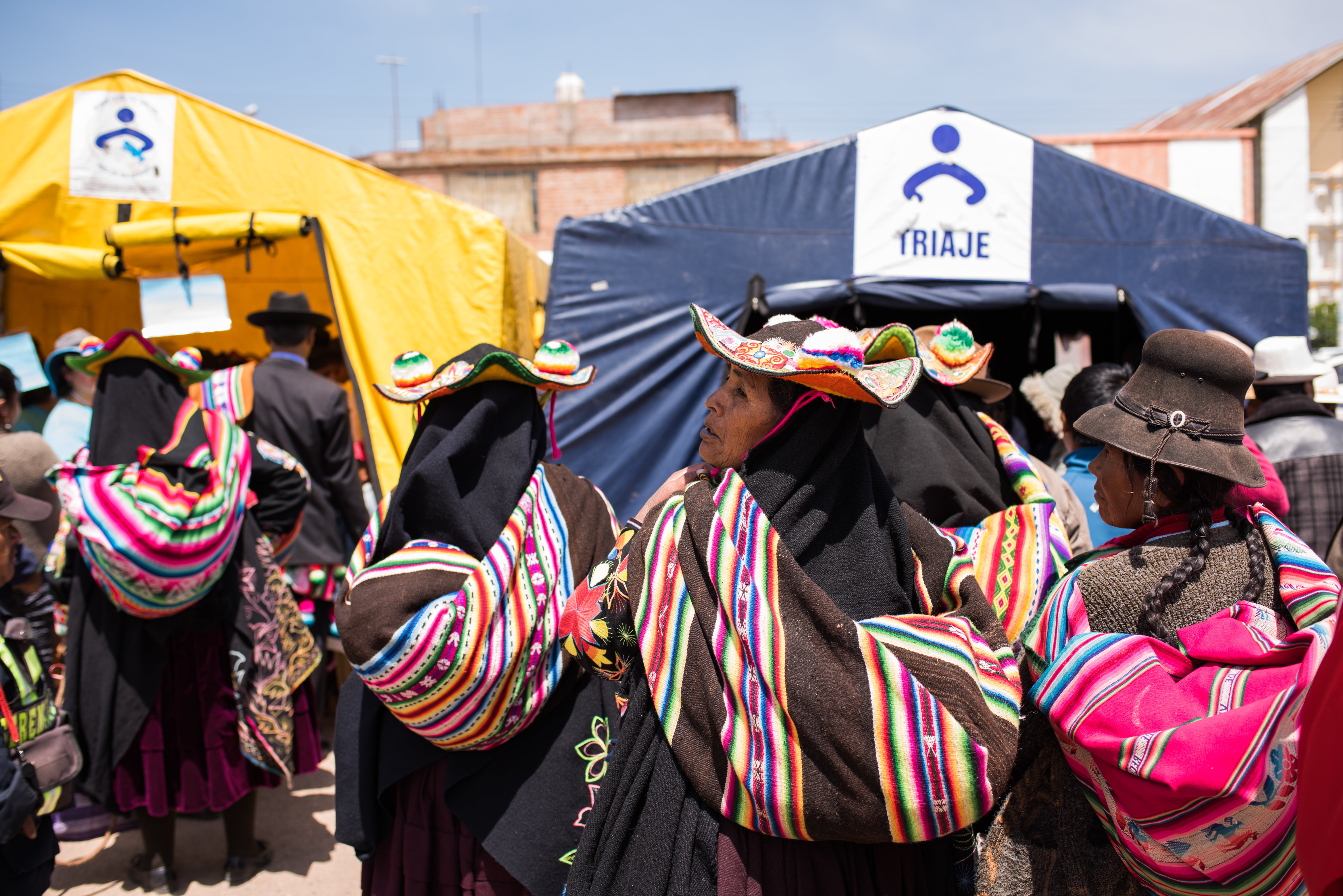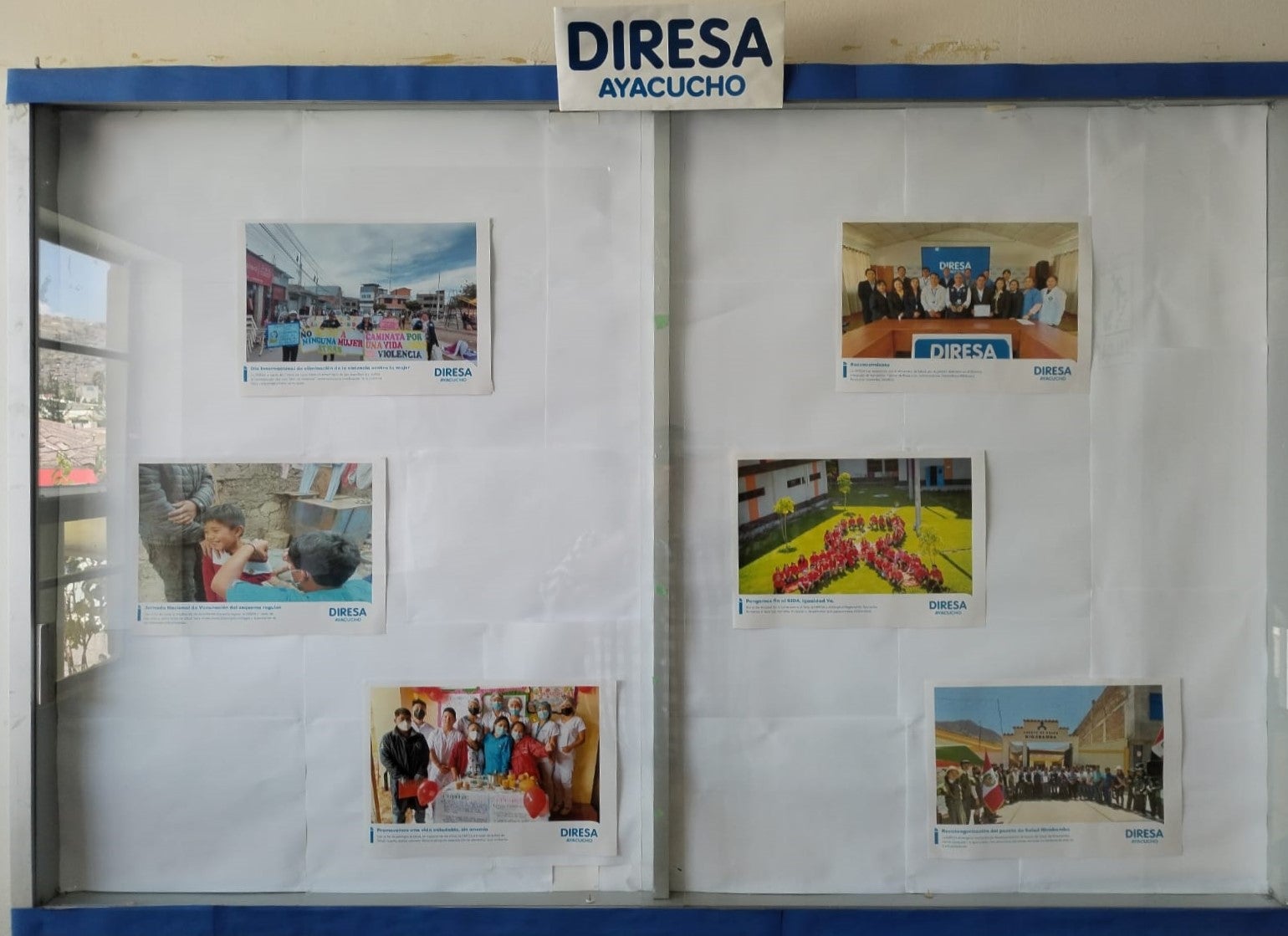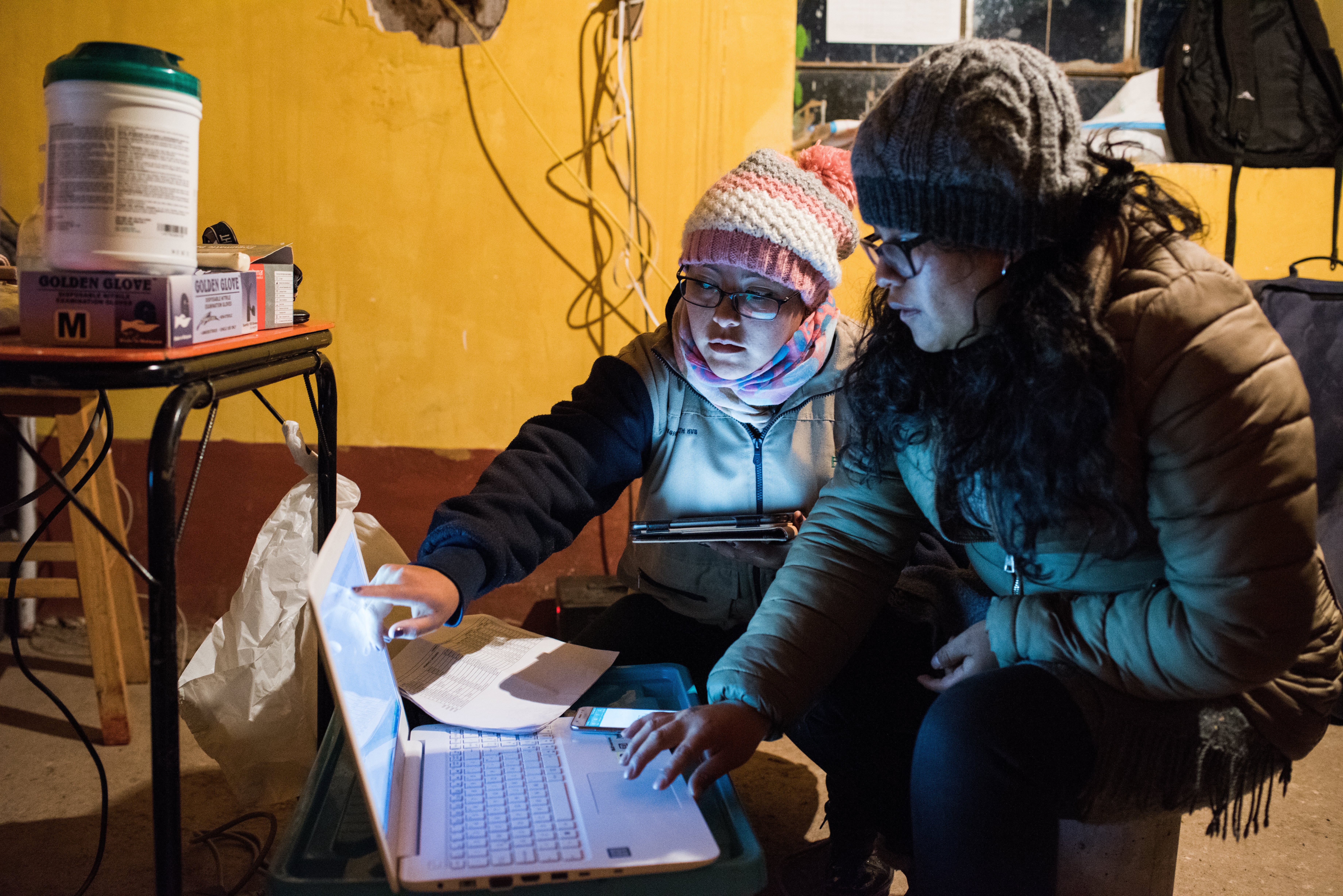In Peru, Exemplars research identified two ways (or pathways) through which reforms have over time improved PHC outcomes. The first pathway strengthened national and local health system governance. The following sections reflect the main themes comprising this pathway.
Key Points
Decades before the Exemplar study period began, local activists in Peru—many of them women in low-income urban neighborhoods—established grassroots organizations aimed at improving nutrition.
Eventually, these programs became part of the government’s health and poverty reduction initiatives in some places, empowering civil society activists to continue to oversee the delivery of primary health care in their communities.
To enable this civil society participation and to boost accountability and good governance, in the early 2000s policymakers in Peru began to gather data on the health system’s performance. They have used this information for strategic planning and to make more transparent decisions about resource allocation, as well as for oversight.
Foundations for community participation in Peru

In 1957, activists from a poor district in Lima established a Club de Madres for local women. The club’s Vaso de Leche (Cup of Milk) program distributed milk and cod liver oil pills donated by the Dutch government to families living nearby, many of whom were recent migrants to the city from poor rural areas. These clubs soon spread nationwide, and the economic crisis of the 1970s spurred them to begin to operate Comedores Populares, or communal kitchens, out of parish churches and other community spaces in and around Lima. Often, these kitchens relied on food and supplies donated by the Catholic Church and other NGOs.
By the 1980s, oil shocks and stagflation had led to a nationwide debt crisis in Peru. At mid-decade, debt service, national defense and the national police, and the Ministry of the Interior consumed more than half of the national budget, and nearly 60% of the Peruvian population lived in poverty. The need for nutritional support programs grew, and the government—first in Lima, and then in other cities and, under President Alan García, nationwide—began to offer funding and other assistance to Clubes de Madres and Comedores Populares.
In 1984, Lima’s metropolitan government created the Vaso de Leche food-relief program, which ultimately distributed one million glasses of milk to poor children and pregnant women via grassroots local committees and neighborhood organizations led by activist women. Vaso de Leche activists also promoted preventive health activities such as immunization, rehydration, and tuberculosis control and prevention.
In the late 1980s and early 1990s, structural adjustment and other austerity-driven economic policies caused unemployment to rise and wages to fall even further. Grassroots nutrition support programs like the Comedores Populares, now aided by NGOs and international donors such as USAID, remained an essential lifeline for low-income Peruvians.
Even as Peru’s economy improved, these community health and support groups continued to thrive. Today, some are still managed by grassroots community organizations; others work under the auspices of local governments. Many are now coordinated by the national Mesa de Concertación para Lucha contra la Pobreza, or Roundtable Against Poverty, established in 2001, which works on cross-sectoral poverty reduction policies at the national and subnational levels., Similarly, in 2002, policymakers and civil society representatives signed onto the Acuerdo Nacional, a national agreement to “guarantee universal access to quality comprehensive health care at no cost and in a timely and ongoing manner, by expanding and strengthening health services, promoting universal access . . . and encouraging the development of a comprehensive, decentralized national health care system.” In effect, this was a blueprint for investing in the poorest states to reduce maternal and child mortality and to ensure equitable access to key PHC services.
The constitutional context for health system reform in Peru
In 1993, President Alberto Fujimori implemented a new constitution to replace the one he suspended during his 1992 autogolpe, or self-coup. The document aimed, in part, to stabilize the country’s economic system by shifting responsibility for many social services from the public sector to the private sector. However, it also established Peruvians’ “right to the protection of ... health” and “to a regime of protection, care, rehabilitation, and security.” To put these new principles into practice, policymakers introduced a plan to restructure the public health sector according to three main objectives:
- Establishing universal health coverage (UHC), including a basic package of services available to all
- Reducing health inequalities
- Expanding geographic access to health services,
As one result, investment in health—which had composed just 4% of the public budget in 1978 —began to increase steadily. For instance, between 1992 and 1996 the number of primary health care (PHC) clinics in Peru doubled, and public programs such as the Fondo Nacional de Compensación y Desarrollo Social (National Compensation and Social Development Fund), or FONCODES, helped cover their operating costs.,
In 2002, two years after Fujimori left office and fled to Japan, Peru reformed its 1993 constitution to temper some of the excesses of the previous decade’s authoritarian rule (including widespread corruption and a broad lack of transparency and accountability in government). Building on a long history of community activism on behalf of poor and marginalized Peruvians, these reforms strengthened local and regional governments as well as civil society organizations representing professional organizations, social groups, and nongovernmental organizations (NGOs).
Self-help and PHC in Peru
Many meaningful early health reforms were influenced by grassroots management of PHC service delivery, building on the Comedores Populares and Vaso de Leches models of community activism for self-help. In 1994, the government institutionalized bottom-up participation in the health system with the Shared Administration Program, which requires regional health departments to contract with local nonprofit organizations known as Comités Locales de Administración de Salud (CLAS), or Local Health Administration Committees, which supervise the delivery of key health services using funds from the Ministerio de Salud (MINSA), or Ministry of Health.,
The CLAS model, which built on Peruvians’ long experience with local self-help organizations, evolved in response to citizen demands for greater health system accountability and improved service delivery—especially in rural areas, which had been disproportionately affected by the civil war of the 1980s. This approach mandated joint decision-making between the MINSA officials funding health services and community organizations, which regularly assessed local health needs and had the power to tailor spending accordingly. It also aimed to improve the quality of care that facilities delivered by empowering facility managers to evaluate the performance of health personnel. (In non-CLAS facilities, managers and health professionals alike were civil servants under MINSA’s comparatively distant administration, and their performance was not routinely assessed.)
In the early years of their operation, CLAS facilities—which were technically not government entities—did not participate in the public sector budgeting process: they could manage their own funds and workforce and implement performance-based contracts and other incentives to foster performance. Studies showed that workers in CLAS facilities were more productive and their users more satisfied than their counterparts at traditional health facilities. By waiving fees for poor patients, they also improved access to care for many low-income Peruvians.
In 2002, nearly 800 CLAS associations managed more than 2,000 health facilities in rural and urban areas—about one-third of all health facilities in Peru. These associations enabled citizen participation in health planning and improved the quality of care Peruvians could receive in their communities.
However, in part because of officials’ resistance to sharing financial and decision-making authority with local communities and in part because physicians in CLAS facilities objected to community oversight of their work (and to the reduced benefits packages CLAS provided compared to public health facilities), financial and political support for the system dwindled over time. MINSA stopped supporting the CLAS system after 2007.
Despite the discontinuation of CLAS, Peru retained elements of citizen empowerment in health programming. Cross-sectoral programs targeting social inclusion and citizen empowerment include Decido Yo, a nonprofit health information platform established in 2018. In Peru, abortion is a crime unless a pregnancy threatens a mother’s life or health, and unsafe, clandestine abortion is the third leading cause of maternal death. Under the supervision of health professionals, Decido Yo promotes the physical, mental, and emotional well-being of people going through an unplanned pregnancy. In collaboration with the International Federation of Medical Students Associations, the platform also organizes trainings for medical students on safe abortion.
Reorganized administrative functions
To increase efficiency by giving more autonomy to the lower levels of the health system, MINSA transferred administrative responsibility for many health facilities to their regional governments (DIRESAs) starting in 2005. However, this decentralization was only partial, because budgetary arrangements often prevented regional governments from managing financing for the health services they delivered.

Even so, study regions in Peru report meaningful autonomy across functions, most commonly in data collection, day-to-day human resources for health management, service delivery model design and implementation, and budget development. Subnational analyses show high managerial autonomy and limited political interference with staffing recruitment decisions at the regional level, while health worker remuneration remains centralized. All regions reported a degree of autonomy to maintain and disburse funds from regional bank accounts. At the same time, regional analyses also show limited independence in procurement decisions, with choices of suppliers often limited by local unavailability.
Data-driven governance and oversight

Peru has long experience with gathering and using data to shape health policy and to improve the delivery of health services: the Encuesta Nacional de Hogares (ENAHO) national household demographic and health survey (DHS) started in 1995.
In 2009, MINSA created the Superintendencia Nacional de Aseguramiento en Salud (SUNASA) to audit its health insurance operations, and in 2013 SUNASA became the Superintendencia Nacional de Salud (SUSALUD). SUSALUD is administratively independent from MINSA, and it has the capacity to supervise public and private providers’ compliance with health regulations as a means of expanding universal health care by defending Peruvians’ right to access quality health services. It regularly monitors and publishes information on all providers listed in RENIPRESS, the national health care provider registry, and its portal hosts a database of provider evaluations.
Since 2004, Peru’s national statistics agency has gathered and reported regional and national demographic and health data each year. Stakeholders can use this Encuesta Demográfica y de Salud Familiar (ENDES) survey data to shape budgets, programs, and initiatives such as the Ministerio de Desarrollo e Inclusión Social (MIDIS). For instance, the Programa Nacional Cuna Más to improve infant nutrition and child development, established under MIDIS in 2012, relies on ENDES data.
Since 2007, officials have also used ENAHO data to monitor PHC performance indicators for Presupuesto por Resultados (PpR, a system for results-based budgeting used by a number of public agencies in Peru). PpR links some MINSA budget allocations to measurable results. At first, most of the priority health programs covered by PpR budgeting were aimed at improving child nutrition and maternal and neonatal health,33 but as of 2021 the practice had expanded in the health sector to include vertical programming related to tuberculosis and HIV/AIDS, NCDs, emergency care, and mental health.32 (Still, programming that used PpR budgeting accounted for less than half of all public spending on health in Peru.)32
Officials measure success by collecting dozens of performance indicators for the programs covered by PpR budgeting. (These indicators are also available to the public via RESULTA, a web application.)32 Evidence suggests that Peru’s utilization of performance indicators to link financing with health outcomes can play a critical role in Peru's improving overall planning and resource allocation decisions. When programs achieve their performance targets, they are rewarded with increases in their budgets—further facilitating their ability to provide key services.32
In Peru, results-based financing additionally enabled improvements in transparency: more data were collected, and more data were published. It also enabled strategic planning and efficient spending: by tying funding to performance, it gave more autonomy to lower levels of the system—including Regional Health Directorates and facilities.
Since 2013, Peru’s national identity card, the Documento Nacional de Identidad, has been electronic, enabling officials to digitally link and analyze demographic, socioeconomic, and health data. This process also helps ensure the equitable distribution and targeting of services according to need. For instance, it is an essential enabler of the JUNTOS cash transfer program aimed at low-income Peruvians.
Cross-sectoral interventions to improve health
Between 2005 and 2016, Peru halved the rate of chronic malnutrition among poor children nationwide. It accomplished this, in part, via a cross-sectoral National Strategy for Combating Poverty and Chronic Child Malnutrition in Peru, known as CRECER. Policymakers launched CRECER in 2007 to coordinate existing social programs under the auspices of different governmental agencies, including those focusing on health, education, cash transfers, water and sanitation, and housing and agriculture. CRECER focused nutrition spending on the poorest communities and empowered regional and municipal governments to oversee its implementation. In 2008, MINSA established a PpR system to monitor the results of the nutritional component of the program, enabling health officials to direct all spending toward interventions with proven results.
